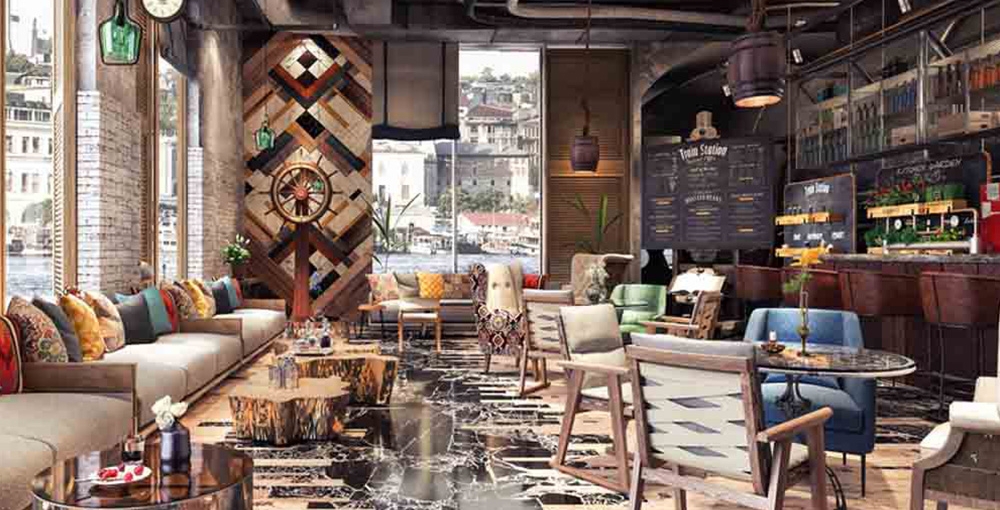Many restaurateurs consider industrial style when looking to give their old business a bit of refresh or when opening the doors of the new establishment for the first time…and it’s easy to understand why. With its effortless blending of metals and warm woods, the industrial style works wonderfully with a variety of restaurants and looks at home both in casual eateries and fine dining establishments.
What many restaurant owners don’t realise is this—within the general term of “industrial style” are a variety of sub-styles…each unique from the other. To help you make sense of it all, we’ll take a deep dive into the world of industrial design style and highlight a few of the sub-styles so you can choose the version of industrial styling that best fits your space.
What is Industrial Style?
Industrial style is a general term used to describe a design trend that encompasses a few key aspects, namely exposed brick, concrete walls and/or floors, weathered and/or distressed woods and metals, and exposed beams and/or pipes. While all these elements are not required for a space to be considered industrial, the blending of two or more of these aesthetics can create an industrial feel within a space.
Color also plays an important role in industrial styling. Expect color to be kept to a minimum, with whites and greys taking center stage. Greenery can add a pop of color, as can artwork but, for the most part, vibrant hues are limited to accent pieces here and there.
Other key elements that play a role in industrial styling are pendant lights, minimalism, the balancing of metals with woods, and the use of plants to keep the industrial elements from reading too cold and austere.
Industrial Sub-Styles
Rustic Industrial
If you love the strong lines of industrial styling but also want to infuse your space with an air of laid-back comfort, rustic industrial will work well for you.
Here, restaurants tend to go heavier with wood and lighter with the metals and/or concrete. Brick is often used to provide the firm elements while still reading organic. Think of a restaurant in a mountaintop ski chalet—warm woods and subdued hues abound, with stone vessels and clay vases serving as accent pieces.
Tables may be made of distressed woods or butcher blocks, and seating may be cozy upholstered booths or distressed metal chairs.
Vintage Industrial
Of all the industrial sub-styles, vintage may be the one that has been most strongly embraced by the restaurant industry.
Here, restaurant owners celebrate the laidback warehouse vibe. Edison bulbs abound, creating an intimate, casual atmosphere. Once again, there’s plenty of wood and metal elements, but they’re used in open, warehouse-type spaces.
The vintage element can be attributed to a “grungy” feel created with worn leather seating and distressed and, sometimes slightly rusty, metal. Contrary to popular opinion, vintage doesn’t have to indicate a certain period—rather, it can hearken back to a time where craftsmanship mattered. Many times, vintage industrial gives off the impression that items were handcrafted long ago.
Scandinavian Industrial
Sometimes referred to as “Scandi-industrial”, this style is a blending of Scandinavian and industrial design elements to create an aesthetic that is warm and functional with plenty of clean lines.
Here, exposed ductwork and polished concrete floors are balanced with light wood tables and plenty of textiles in the form of upholstered seats, warm leathers, and woven materials used as table runners.
There’s often a nod to farmhouse chic, with spindled chairs and pendant lighting, but you’ll find that chairs are painted charcoal to contrast against white pine tables.
Modern Industrial
When it comes to modern industry, the furniture and lighting often take center stage. Bold, eye-catching pendant lights hang over warm, wooden tables. Seating can run the gamut, from stylized modern shapes in neutral colors to leather and metal chairs with detailed legs.
Modern industrial restaurants are quick to embrace softening foils to the hard lines of industrial styling. Don’t be surprised to find plenty of greenery and/or textiles to balance out the masculine vibe created by wood and concrete. Seating may be covered in lush velvet or richly colored leather. Other unique features may include feature walls of textured wallpaper or living walls covered in succulents.
Urban Industrial
Last, but certainly not least, we have urban industrial, which takes its inspiration from materials seen in most cityscapes—the glass, brick, steel, and concrete of modern buildings blended with the brick and wood of older industrial structures.
Urban industrial restaurants are a bit sleeker and more polished than other industrial subsets. Rustic is left behind while all things cosmopolitan are embraced. This often includes a more frequent use of eye-catching color.
Tables and seating often use wood and appear raw and/or unpolished. Metal is used as accents, often in the table and chair legs, though metal chairs may be used.
Once again, pendant lights abound here. You’ll also see exposed ductwork and plumbing that creates the feeling of dining in the basement of some mid-city building.
There is no end to the variety of styles the industrial design movement provides. Finding the style that’s right for you requires a bit of forethought and a clear understanding of your budget. Once you know what you can afford to spend, you can find industrial inspired pieces within your price range.
Be sure to visit our website or stop by our showroom to see a variety of industrial tables and seating options. We have plenty of options at various price points to ensure you’ll be able to create the industrial restaurant space of your dreams.
Thanks for reading,
Have a Seat
1300 715 937

